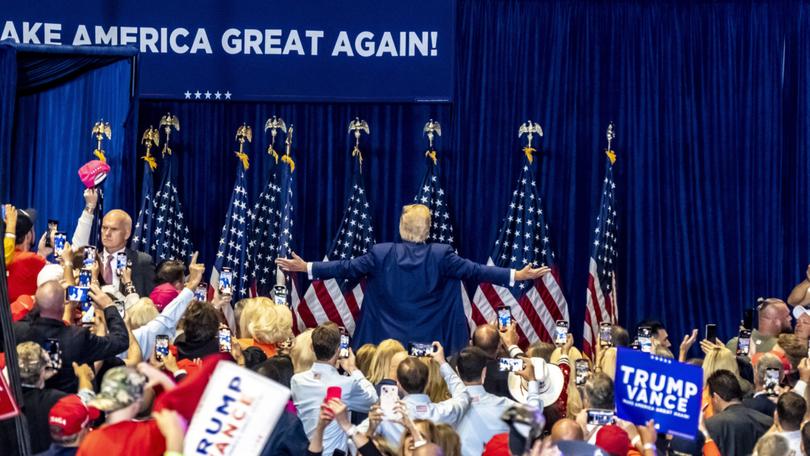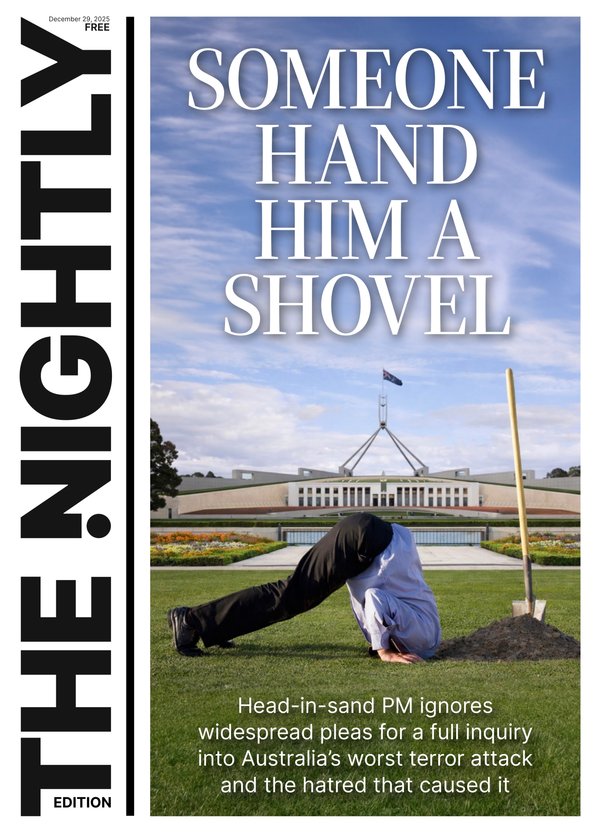THE NEW YORK TIMES: Why the MAGA movement has become a problem for Donald Trump

In 2024, the deep state that defeats Donald Trump might be his own.
That, after all, is what Project 2025 was actually meant to be. The 900-page tome that Democrats hoist in front of the cameras is a festival of policy options, detailed down to the sub-agency level. But options for whom? Not for Trump himself. Even the most wonkish of presidents can only engage in a small fraction of what the executive branch does. And Trump was not the most wonkish of presidents. When he said, during his debate with Kamala Harris, that he hadn’t read Project 2025 and has no intention of doing so, I believed him.
But Project 2025 — and much else like it that has gotten less press — is more than a compendium of policy proposals: It is an effort to build a deep state of Trump’s own. The presidency is not one man, Diet Coke in hand, Fox & Friends on TV, barking orders. It’s 4,000-or-so political appointees — nearer to 50,000 if Trump again uses Schedule F powers to strip civil-service protections from vast swaths of the federal government — trying to do what they think the president wants them to do or what they think needs to be done. They do that by setting policies for the more than 2 million civilian employees of the federal government and by writing regulations that the rest of society must follow.
Sign up to The Nightly's newsletters.
Get the first look at the digital newspaper, curated daily stories and breaking headlines delivered to your inbox.
By continuing you agree to our Terms and Privacy Policy.Veterans of Trump’s administration believe personnel was their biggest problem. They could not act ambitiously or swiftly enough because they were at constant war with the government they, in theory, controlled. Part of this reflected Trump’s erratic leadership style and the constant conflict between the warring factions inside his White House: the traditional Republicans clustered around Mike Pence and Reince Priebus; the MAGA types led by Steve Bannon and Stephen Miller; the foreign policy establishment that spoke through H.R. McMaster and Nikki Haley; the corporatists led by Jared Kushner and Gary Cohn. Read any book on the Trump presidency, and you will be buried in examples of Trump’s top appointees trying to foil each other — and him.
But some of it reflected a federal bureaucracy that resisted Trump and the people he appointed. In a presentation at the 2024 National Conservatism conference in Washington, Katy Talento, who oversaw health care policy on Trump’s Domestic Policy Council, described the obstacles she faced:
“There’s like a handful of political appointees at an agency with hundreds of thousands of employees and maybe one or two of those appointees is sufficiently experienced to write regulations. They can’t seek any help from experienced but hostile bureaucrats that surround them, or those drafts get leaked, or bad advice gets provided, and poison pills get put into regs, drafts get slowed down or scuttled all together. So this dramatically limits the productivity potential of a Republican administration.”
This is the problem groups like Project 2025 set out to solve. Behind the policy playbook sits a database of around 20,000 applicants ready to be part of the next Trump administration. And that database is still growing. There is an online portal that, even now, invites applicants to apply for inclusion in “the Presidential Personnel Database.” It goes on to say that “with the right conservative policy recommendations and properly vetted and trained personnel to implement them, we will take back our government.”
To do that, the next Trump administration must first clear out or conquer the federal government that currently exists. Project 2025 is obsessed with this task and many of its 900-some pages are dedicated to plans and theories for how this might be done.
“The great challenge confronting a conservative President is the existential need for aggressive use of the vast powers of the executive branch to return power — including power currently held by the executive branch — to the American people,” writes Russ Vought, Trump’s former director of the Office of Management and Budget, in one of its chapters. Victory will require the “boldness to bend or break the bureaucracy to the presidential will.”
This, I would say, is the unifying theory of a second Trump term. Purge or break the federal bureaucracy. Fill it with vetted loyalists. Then use its power to pass policy, yes, but also to break or conquer the other institutions in American life that so vex Trump and his supporters. “We are in the process of the second American Revolution, which will remain bloodless if the left allows it to be,” Kevin Roberts, president of the Heritage Foundation, which oversaw Project 2025, said in July.
By all accounts, Trump and his campaign are furious that Project 2025 has been hung like a millstone around his neck. But there are two reasons their disavowals have counted for little. The first is that the campaign has treated Trump’s policy plans like a secret the public can only be let in on after his victory. His issues page is a joke, his official platform a Delphic collection of all-caps aphorisms backed up by the occasional bullet point.
The next Trump administration will do far more than the Trump campaign is describing, and Project 2025 — which was produced with input from more than 100 conservative organizations that see themselves as part of the MAGA-governing coalition — filled the void that Trump himself has left. He did not tell us what he was going to do, so Project 2025 did.

The second is that Trump’s 2024 campaign differs from his 2016 campaign in a fundamental way. In 2016, Trump ran as the destroyer of the existing Republican coalition. He won by humiliating the politicians who had held power before him, but he did not, during that campaign, attempt to replace them. And so Trump presided over a kind of uneasy coalition government with the Republican Party of Paul Ryan and Mitch McConnell. His major domestic policy projects reflected that coalition: Repeal of Obamacare was what united congressional Republicans in 2016, so that’s what the Trump administration attempted in 2017. Cutting corporate taxes is what got Speaker Ryan out of bed in the morning, so that is what the Trump administration turned to next.
But now Trump is the leader of the Republican coalition. He cannot credibly divorce himself from the groups working day and night to secure his victory and staff his presidency. There is no competing power center that the media or the public can assume will do the governing that so bores Trump. But Trump is not temperamentally suited to the work of managing a coalition and he has not elevated a trusted ideological consigliere to do it for him. He is a diffident, distracted ruler, and the result is dozens of groups competing for his favor and unsure of how to win it.
The Heritage Foundation was one of these groups and Project 2025 their signature effort. In 2021, Roberts took over Heritage and retooled it into an organization dedicated to “institutionalizing Trumpism.” He sought centrality through both scale and publicity: Project 2025 was a vast undertaking, and Roberts promoted it relentlessly. This is now seen as folly, but it is easy enough to follow the original logic: Heritage has experience putting together governing documents for insurgent candidates, going back to the Mandate for Leadership that Ronald Reagan relied on in 1981, and Trump often rewards the loyalists he notices fighting for him in public. But Roberts went too far.
“The problem, which I had always suspected, was that very few plans survive contact with Donald Trump,” said Matthew Continetti, author of “The Right: The Hundred-Year War for American Conservatism.” “He always wants to maintain maximum flexibility and maximum maneuverability in order to improve his position at any given moment. So he was not just going to turn around and say, yes, Project 2025 is exactly what my program will be, and it’s exactly who I plan to have in my administration.”
But if Trump wins, he will need plans and he will need people. And so the problems that Project 2025 has caused for Trump in the campaign would also bedevil his presidency.
The MAGA coalition — particularly its elected officials and Washington staffer class — has grown beyond Trump. It has more views on more issues than he does. It has absorbed more specific and unusual ideologies than he has. It is more hostile to abortion than he is, or than he wants to appear to be. It is more committed to deregulating health insurance than he is, or than he wants to appear to be. There is a great gap between the MAGA leader who slept with a porn actor and the factions in the MAGA movement that want to outlaw pornography, as Roberts proposed on Project 2025’s first page.
Trumpism is whatever Trump says it is, but MAGA is whatever his movement becomes. This is why JD Vance has been a political liability to Trump’s campaign: Vance represents MAGA as it has evolved — esoterically ideological, deeply resentful, terminally online — unleavened by Trump’s instincts for showmanship and the winds of public sentiment. It is telling that it is Vance, not Trump, who wrote a glowing forward to Roberts’ forthcoming book. Trump is where MAGA started, but Vance and Roberts are where it is going.
Trump’s problem in the 2024 election is that he can no longer run as if he is a man alone. Everyone knew Pence did not represent Trumpism. But Trump chose Vance to be the heir of the MAGA movement. A Trump administration would be full of people like Vance pursuing the agendas they believe in. In the Talento presentation I mentioned, she describes the Biden administration as “a federal leviathan that is killing our babies” and argues that “every Cabinet secretary who comes into a new, hopefully Republican administration will have a pro-life agenda that they must enact.” This is not Trump’s election-year message but it would be his administration’s reality.
Another Trump administration would be filled with people pursuing agendas like this at every level, and properly so: That is what coalitions do when they win elections. But this is why Trump’s disavowals ring so false: He is denying a reality of his second term that everyone else can plainly see. Project 2025 is not a perfect guide to that second term, but it the closest thing we have to one. It was all so much easier when the deep state was something Trump could complain about, rather than something he had to manage and own.
This article originally appeared in The New York Times.
© 2024 The New York Times Company
Originally published on The New York Times
